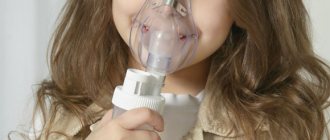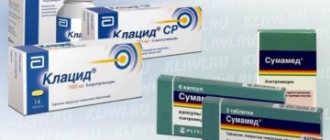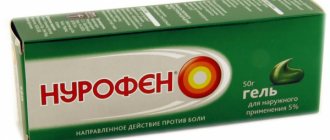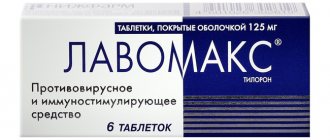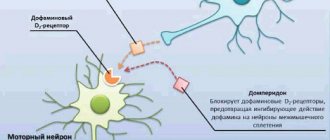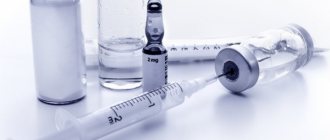General information about the drug, composition and release form
Nurofen for children is an anti-inflammatory drug that has analgesic and antipyretic effects. 5 ml of Nurofen contains 100 mg of ibuprofen, which inhibits the action of protoglastids, which are mediators of pain and inflammation. It is characterized by a high absorption rate, and therefore a rapid effect.
Nurofen is prescribed to small children from 3 months of age, in appropriate dosages, and its effect will be effective for children up to 12 years of age. Most often, Nurofen is prescribed as an antipyretic, but the range of its effects is much wider. The drug is available both in the form of tablets with different dosages, and in the form of a suspension.
Pharmacological action of Nurofen
The active substance in Nurofen is ibuprofen, a derivative of phenylpropionic acid. When taken orally, it suppresses the formation of prostaglandins - substances that cause an inflammatory reaction in the human body (so-called inflammatory mediators), resulting in an anti-inflammatory, analgesic and antipyretic effect.
There are reviews of Nurofen from researchers indicating that it stimulates the production of the body’s own interferon, a substance that is one of the main factors of immunity. Thus, one of the additional actions of ibuprofen is stimulation of the immune system, which makes the use of Nurofen justified in the treatment of viral infections.
Indications for use
- Acute respiratory diseases
- Migraine
- Childhood infections
- Ear and throat pain
- Headaches and toothaches
- Flu
- Neuralgia
- Post-vaccination infections
- Pain from sprains and injuries
Despite the fact that Nurofen helps well with any pain and inflammation, not everyone can use it. Before giving your child any medicine, be sure to read the contraindications so as not to harm or worsen the patient’s condition.
Before accepting a prescription from a doctor, be sure to warn him about the presence of all the characteristics and diseases of the child.
Drug interactions with other drugs
Nurofen can actively interact with some other groups of drugs, so it is not recommended to take it simultaneously with the following medications:
- Acetylsalicylic acid – the risk of adverse reactions increases, and the effectiveness of the drugs decreases;
- Anticoagulants - ibuprofen enhances the blood thinning effect. If it is absolutely necessary to take it, the dosage of anticoagulants should be adjusted, taking into account the effect of Nurofen;
- Tacrolimus – significantly increases the toxic effect on the kidneys;
- Cardiac glycosides - the failure of the heart worsens, glomerular filtration in the nephrons of the kidneys is disrupted, the active components of cardiac glycosides accumulate in the blood plasma;
- Mifepristone - the effectiveness of the drug decreases. You can take Nurofen no earlier than 10 days after the last use of Mifepristone;
- Quinolones – convulsions develop;
- Another drug from the NSAID group - when taking two or more drugs of the same group at the same time, the risk of overdose and complications significantly increases;
- Medicines that lower blood pressure - firstly, their effectiveness decreases, and secondly, the toxic effect of ibuprofen on the liver increases;
- Cyclosporine – increased nephrotoxicity;
- Zidovudine – increased hepatotoxicity.
This is interesting: products that lower blood pressure
Regarding the simultaneous use of Nurofen with any other drugs, you should consult your doctor. Otherwise, the medications will not have any effect, or, worse, will lead to unpleasant consequences - problems with the liver, kidneys, allergies, changes in the blood.
Contraindications to the use of the drug "Nurofen for children"
- Individual hypersensitivity to the active substance - ibuprofen, as well as to the components: acytylsalicylic acid and other NSAIDs.
- Kidney failure
- All blood diseases
- Ulcerative diseases of the gastrointestinal tract
- Hyperkalemia
- Heart failure
- Fructose intolerance
- Bronchial asthma
- Children up to 3 months of age.
If your child does not have any contraindications to the drug, you should carefully study the dosage for each age.
Contraindications
Nurofen should not be prescribed to a child if the following conditions exist:
- hypersensitivity to ibuprofen and other components included in the composition;
- intolerance to non-steroidal anti-inflammatory drugs, in particular acetylsalicylic acid;
- bronchial asthma, as well as polyps in the nose and paranasal sinuses;
- cerebrovascular and other bleeding;
- bleeding disorders such as hemophilia;
- hyperkalemia;
- allergic reactions to fructose;
- heart failure;
- pathological changes in the liver and kidneys (for example, liver failure).
The medication is not prescribed to patients weighing less than 5 kg.
Dosage and method of administration
The drug is taken orally. The fastest effect occurs when taken on an empty stomach with water. However, patients with gastric hypersensitivity are advised to take this drug with meals.
We recommend: Thuja oil for adenoids for children
The dosage of the drug is regulated by the age of the child:
- 3-6 months daily dose is 150 mg
- 6-12 months daily dose is 200 mg
- 1-3 years the daily dose is 300 mg
- 4-6 years old daily dose is 400 mg
- 7-9 years old daily dose is 600 mg
- 9-12 years old daily dose is 900 mg
The daily dose should be divided into 3 doses. If the drug is used as an antipyretic, then the time of its administration is limited to 3 days. The drug can be taken as a pain reliever for no more than 5 days. If after this time the symptoms persist, the use of the medicine should be stopped and you should consult a specialist. Shake the suspension before use.
Application
For ease of use of the suspension, a measuring syringe is included with the drug. Before use, the medicine must be shaken vigorously, and then the measuring syringe must be firmly attached to the neck of the bottle. The container with syrup should be turned upside down and slowly begin to pull the piston towards you. When the amount of the drug in the syringe reaches the desired division, the bottle is returned to its original position and the syringe is carefully removed. The child is given the medicine by placing a syringe in the mouth and carefully releasing the suspension. After the procedure, the measuring device is thoroughly washed in hot water and dried in a place where children have no access.
| Patient age | Body mass | Amount of drug | Frequency of use |
| From 3 to 6 months | Not less than 5 kg | 2.5 ml | No more than 3 times a day |
| From 6 to 12 months | 6 – 10 kg | 2.5 ml | 3 - 4 times a day |
| From 1 to 3 years | 10 - 15 kg | 5 ml | 3 - 4 times within 24 hours |
| From 4 to 6 years | 15 - 20 kg | 7.5 ml | 3 - 4 times a day |
| From 7 to 9 years old | 21 - 29 kg | 10 ml | 3 - 4 times a day |
| From 10 to 12 years | 30 — 40 | 15 ml | 3 - 4 within 24 hours |
More interesting things
What does paracetamol help with? Detailed instructions for use
An interval of at least 6 hours should be maintained between doses of the drug. The syrup should not be used for more than 3 days as a fever reducer, and for more than 5 days as a pain reliever. For children with sensitive stomachs, the medication is prescribed after meals.
Side effects
If the drug is used in limited dosages for a short course, side effects will be minimized.
But if the following symptoms occur, the dosage must be reduced, or even stopped using the drug:
- Diarrhea
- Nausea and vomiting
- Fever
- Skin rash
- itching
- Headache and dizziness
- Insomnia
- Cystitis
- Anemia
- Tachycardia
- Decreased blood pressure
In case of overdose, the following treatment is recommended:
- Gastric lavage
- Taking 2 tablets of activated carbon
- Drinking plenty of alkaline drinks
- Symptomatic therapy
Nurofen side effects
When using the drug Nurofen® for 2-3 days, practically no side effects are observed.
In case of long-term use, the following side effects may occur:
- From the gastrointestinal tract: nausea, vomiting, heartburn, anorexia, pain and discomfort in the epigastrium, diarrhea, flatulence, possible erosive and ulcerative lesions of the gastrointestinal tract (in some cases complicated by perforation and bleeding), abdominal pain, irritation , dryness of the oral mucosa or pain in the mouth, ulceration of the gum mucosa, aphthous stomatitis, pancreatitis, constipation, hepatitis.
- From the nervous system: headache, dizziness, insomnia, agitation, drowsiness, depression, confusion, hallucinations, rarely - aseptic meningitis (more often in patients with autoimmune diseases).
- From the cardiovascular system: heart failure, increased blood pressure (BP), tachycardia.
- From the urinary system: nephrotic syndrome (edema), acute renal failure, allergic nephritis, polyuria, cystitis.
- From the hematopoietic organs: anemia (including hemolytic, aplastic), thrombocytopenia and thrombocytopenic purpura, agranulocytosis, leukopenia.
- From the senses: hearing loss, ringing or noise in the ears, reversible toxic optic neuritis, blurred vision or diplopia, dryness and irritation of the eyes, swelling of the conjunctiva and eyelids (allergic origin), scotoma.
- Allergic reactions: skin rash, itching, urticaria, Quincke's edema, anaphylactoid reactions, anaphylactic shock, fever, erythema multiforme (including Stevens-Johnson syndrome), toxic epidermal necrolysis (Lyell's syndrome), eosinophilia, allergic rhinitis.
- From the respiratory system: bronchospasm, shortness of breath.
- Other: increased sweating.
With long-term use in large doses - ulceration of the mucous membrane of the gastrointestinal tract, bleeding (gastrointestinal, gingival, uterine, hemorrhoidal), visual impairment (impaired color vision, scotoma, amblyopia). If side effects occur, you should stop taking the drug and consult a doctor.
Overdose
Symptoms: abdominal pain, nausea, vomiting, lethargy, drowsiness, depression, headache, tinnitus, metabolic acidosis, coma, acute renal and liver failure, gastrointestinal bleeding, decreased blood pressure (BP), bradycardia, tachycardia, atrial fibrillation, respiratory arrest, increased prothrombin time, rarely convulsions.
Symptoms: abdominal pain, nausea, vomiting, lethargy, drowsiness, depression, headache, tinnitus, metabolic acidosis, coma, acute renal and liver failure, gastrointestinal bleeding, decreased blood pressure (BP), bradycardia, tachycardia , atrial fibrillation, respiratory arrest, increased prothrombin time, convulsions are rarely possible.
Treatment: gastric lavage (only within an hour after administration), activated charcoal, alkaline drinking, forced diuresis, symptomatic therapy. In case of frequent or prolonged seizures, it is necessary to use anticonvulsants (diazepam or lorazepam intravenously).
Interaction with other drugs
It is not recommended to take Nurofen® tablets simultaneously with acetylsalicylic acid (ASA) and other NSAIDs. When administered simultaneously, ibuprofen reduces the anti-inflammatory and antiplatelet effect of acetylsalicylic acid (ASA) (an increase in the incidence of acute coronary insufficiency in patients receiving small doses of acetylsalicylic acid (ASA) as an antiplatelet agent is possible after starting to take ibuprofen).
When prescribed with anticoagulant and thrombolytic drugs (alteplase, streptokinase, urokinase), the risk of bleeding simultaneously increases. Cefamandole, cefaperazone, cefotetan, valproic acid, plicamycin, increase the incidence of hypoprothrombinemia. Cyclosporine and gold preparations enhance the effect of ibuprofen on the synthesis of prostaglandins in the kidneys, which is manifested by increased nephrotoxicity.
Ibuprofen increases the plasma concentration of cyclosporine and the likelihood of developing its hepatotoxic effects. Drugs that block tubular secretion reduce excretion and increase plasma concentrations of ibuprofen. Inducers of microsomal oxidation (phenytoin, ethanol, barbiturates, rifampicin, phenylbutazone, tricyclic antidepressants) increase the production of hydroxylated active metabolites, increasing the risk of severe hepatotoxic reactions.
Inhibitors of microsomal oxidation - reduce the risk of hepatotoxicity. Reduces the hypotensive activity of vasodilators, natriuretic in furosemide and hydrochlorothiazide. Reduces the effectiveness of uricosuric drugs, enhances the effect of indirect anticoagulants, antiplatelet agents, fibrinolytics. Increases the side effects of mineralocorticosteroids, glucocorticosteroids, estrogens, ethanol. Enhances the effect of oral hypoglycemic drugs, sulfonylurea derivatives and insulin.
Antacids and cholestyramine reduce absorption. Increases the blood concentration of digoxin, lithium preparations, methotrexate. Caffeine enhances the analgesic effect.
Special instructions:
During long-term treatment, monitoring of the peripheral blood picture and the functional state of the liver and kidneys is necessary. When symptoms of gastropathy appear, careful monitoring is indicated, including esophagogastroduodenoscopy, a complete blood count (hemoglobin determination), and a stool test for occult blood. If it is necessary to determine 17-ketosteroids, the drug should be discontinued 48 hours before the study. During the treatment period you should refrain from drinking alcoholic beverages.
Effect on the ability to drive or operate machinery
Patients should refrain from all activities related to driving vehicles and working with moving mechanisms, as well as other types of potentially hazardous activities associated with concentration and increased speed of psychomotor reactions.
Release form: Film-coated tablets. 200 mg. 6,8,10 or 12 tablets per blister (PVC / PVDC / aluminum). One blister (6,8,10 or 12 tablets each) or two blisters (6,8,10 or 12 tablets each) or 3 blisters (10 or 12 tablets each) or 4 blisters (12 tablets each) or 8 blisters (each 12 tablets) together with instructions for use are placed in a cardboard box or plastic container.
Photo of the packaging of Nurofen tablets, which indicates the release date, series and until what year these tablets are valid
Photo of a blister of Nurofen tablets, front side
Photo of a blister of Nurafen tablets, back side
Shelf life: 3 years. Do not use a drug that has expired.
Storage conditions
Store in a dry place at a temperature not exceeding +25° C. Keep the drug out of the reach of children!
Photo of the packaging of Nurafen tablets where storage conditions and manufacturer are indicated
Conditions for dispensing from pharmacies
Over the counter.
Name and address of the legal entity in whose name the registration certificate was issued
Reckitt Benckiser Healthcare International Ltd, Thane Road, Nottingham, NG90 2DB, UK
You can obtain additional information about the drug, as well as send your complaints and information about adverse events to the following address in Russia.
Russia, 115114, Moscow, Kozhevnicheskaya st., 14 Tel: 8-800-505-1-500 (toll-free),
Special instructions for use
Nurofen for children can be used to treat children with diabetes mellitus due to the absence of sugar and dyes in the composition of the drug. Children with gastritis, gastrointestinal bleeding, kidney and liver diseases, as well as when taking other analgesics and diuretics, should use this drug with extreme caution.
An exacerbation of these diseases and the manifestation of side symptoms is possible due to the enhancement of additional agents containing unidirectional active ingredients.
Also, a decrease in the effectiveness of diuretic drugs due to the multidirectionality of the active component.
Nurofen tablets composition
One film-coated tablet contains the active substance: 200 mg of ibuprofen;
excipients: croscarmellose sodium 30 mg, sodium lauryl sulfate 0.5 mg, sodium citrate dihydrate 43.5 mg, stearic acid 2.0 mg, colloidal silicon dioxide 1.0 mg.
Shell composition: carmellose sodium 0.7 mg, talc 33.0 mg, acacia gum 0.6 mg, sucrose 116.1 mg, titanium dioxide 1.4 mg, macrogol 6000 0.2 mg, black ink [Opacode S-1 -277001] (shellac 28.225%, iron dye black oxide (E172) 24.65% propylene glycol 1.3%, isopropanol 0.55%, butanol 9.75%, ethanol 32.275%, purified water 3.25%). 'Solvents that have evaporated after the printing process.
Description:
Round, biconvex, white or off-white film-coated tablets with black Nurofen imprint on one side of the tablet. On a cross-section of the tablet, the core is white or almost white, the shell is white or almost white.
Pharmacological group:
non-steroidal anti-inflammatory drug (NSAID).
ATX code:
M01AE01
pharmachologic effect
The drug belongs to non-steroidal anti-inflammatory drugs (NSAIDs). Nurofen® has analgesic, antipyretic and anti-inflammatory effects. Indiscriminately blocks COX1 and COX2. The mechanism of action of ibuprofen is due to inhibition of the synthesis of prostaglandins - mediators of pain, inflammation and hyperthermic reaction.
Formokinetics:
Absorption is high, binding to plasma proteins is 190%. Slowly penetrates into the joint cavity, lingers in the synovial tissue, creating higher concentrations in it than in plasma. Lower concentrations of ibuprofen are found in cerebrospinal fluid compared to plasma.
After absorption, about 60% of the pharmacologically inactive R form is slowly transformed into the active S form in the gastrointestinal tract and liver. Metabolized in the liver. The time to reach the maximum concentration in plasma Tmax is 1-2 hours. The half-life is 2 hours. It is excreted by the kidneys (70-90% of the administered dose in the form of ibuprofen and its metabolites; unchanged, no more than 1%) and, to a lesser extent, with bile (less than 2%).
Analogues of the drug
Nurofen has several analogues in terms of active substance and therapeutic effect. The main and most common of them:
- Ibuprofen
- Moment
- Paracetamol
- Eferalgan
When using any medicine, you need to remember 3 main points: indications for use, contraindications and dosage. It is highly discouraged to use medications for patients with contraindications, even in small quantities. Do not exceed the dosage in an attempt to force the result of treatment. Use medications as prescribed, in limited dosages for a short course and get better!
Analogues of the drug Nurofen
Analogs for the active substance:
- Bonifen.
- Children's Motrin.
- Ibuprofen Nycomed.
- Ibuprofen-Hemofarm.
- Dolgit.
- Ibusan.
- Ibutop gel.
- MIG 400.
- Nurofen UltraCap.
- Nurofen forte.
- Solpaflex.
- Yprene.
- Pedea.
- Faspik.
- Brufen.
- Advil.
- ArthroCam.
- Ibuprofen.
- Nurofen Period.
- Ibuprofen Lannacher.
- Ibufen.
- MIG 200.
- Nurofen for children.
- Burana.
- Deblock.
- Ibuprom.
- Nurofen Express.





